Paris
Top-Rated Tourist Attractions in Paris
Whether sunshine is sparkling on the café terraces of Boulevard Saint-Germain or melancholy mists of the Seine River are shrouding Notre-Dame Cathedral, the magical ambience of Paris has a way of romancing visitors. This incomparable city is filled with grandiose monuments like the Eiffel Tower, the Arc de Triomphe, and the Panthéon. Yet the charm of Paris lies in the small details: the quaint cobblestone streets, perfectly manicured trees, dainty tea salons, Belle Epoque brasseries, and avant-garde art galleries. Like a veritable open-air museum, the city's buildings are works of art, and the Parisians' everyday fashion is worthy of a magazine spread.
A world of discovery awaits in the distinctive quartiers (neighborhoods): the winding labyrinth of old streets in the medieval Latin Quarter, the legendary café scene in Saint-Germain-de-Prés, and the Bohemian village atmosphere of Montmartre. In every hidden corner and at all the famous sites, Paris casts a spell of enchantment. One visit may inspire a lifelong love affair. Find the best places to visit in this magical city with our list of the top tourist attractions in Paris.
1. Eiffel Tower
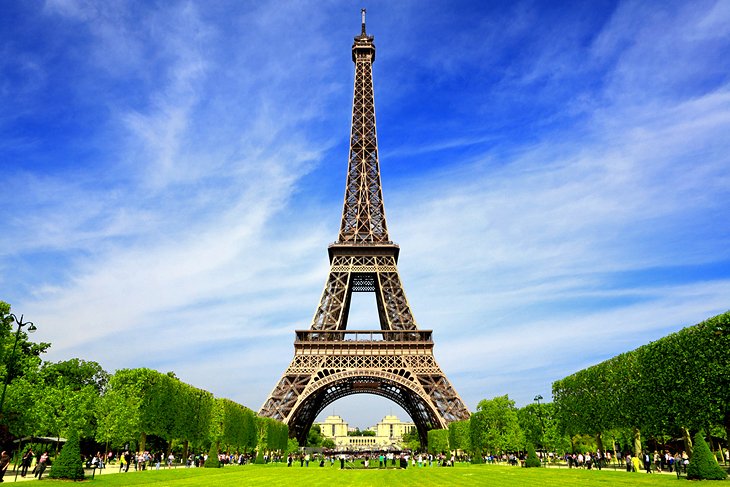
Eiffel Tower
The most visited tourist attraction in Paris, the Eiffel Tower also ranks high on the list of places to visit in France. It's hard to believe that the structure was dismissed as a monstrosity when it was first unveiled. The iconic tower was designed by Alexandre-Gustave Eiffel for the Paris Exhibition of 1889, which marked the centenary of the French Revolution.
The tower consists of 18,000 sturdy iron sections (weighing over 10,000 tons) held together by 2.5 million rivets. This innovative structure is now considered a masterful architectural feat and is the most emblematic sight in Paris. From the Jardins du Trocadéro and the lawns of the Champs de Mars, there is just the right distance from the Eiffel Tower for a picture-perfect photo-op. Reaching 324 meters in height, the tower was the world's tallest building until the Empire State Building was erected.
Visitors can take an elevator or walk up the 360 steps to arrive at the first level (at 57 meters) and 344 more steps to the second level (at 115 meters). The outlooks from both the first and second level are spectacular. To reach the top level, at the dizzying elevation of 276 meters, requires an exhilarating elevator ride from the second level. Visiting the top level is one of the most thrilling things to do in Paris, but it's not for the faint of heart.
For those who'd like to indulge in a gourmet meal, the Jules Verne Restaurant is on the second floor. This restaurant features expansive windows, which allow diners to enjoy the amazing panoramas.
It's best to purchase tickets in advance especially if visiting during high season. To ensure the best experience possible, tourists can sign up for the Eiffel Tower Priority Access Tour. This one-hour tour allows tourists to avoid standing in several long lines and offers the added benefit of educational commentary. A knowledgable guide will share interesting information and provide historical context.
- 2. Musée du Louvre
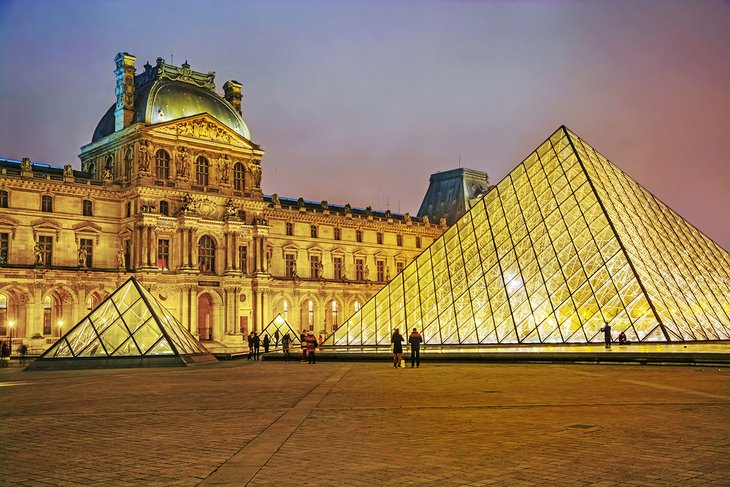
Louvre Museum
A sumptuous palace that was once the home of France's Kings, the Louvre is the most important of Paris' top museums. Visitors enter the museum in the courtyard of the palace at the glass pyramid (designed by Ieoh Ming Pei in 1917). The Louvre Museum possesses more than 30,000 artworks (many considered masterpieces)—from antiquities to European paintings of the 15th to 19th centuries.
It is impossible to see it all in one visit, but tourists can focus on a particular gallery, such as classical sculpture, Italian Renaissance art, or 17th-century French paintings, or take a self-guided tour to see the Louvre Museum's highlights.
The most famous piece is the Mona Lisa or La Gioconda (or La Joconde in French) painted by Leonardo da Vinci in 1503-1505. Other exceptional works are the ancient Venus de Milo sculpture, the monumental Victory of Samothrace of the Hellenistic period, the immense Wedding Feast at Cana painting by Veronese (1563), and Botticelli's frescoes. Also a must-see is Liberty Leading the People (1831) by Eugène Delacroix, depicting the Parisian uprising of July 27th to 29th, 1830 known as "Trois Glorieuses" ("Three Glorious Days").
To get the most out of a visit to the Louvre, tourists can take a guided tour. The Skip the Line: Louvre Museum Tour allows participants to jump ahead of the long queues and head straight to the museum's most famous artworks, including the Venus de Milo and the Mona Lisa. On this three-hour tour, a knowledgeable guide discusses the collections, explains interesting information about the paintings, and answers questions.
The Louvre is surrounded on one side by the Jardin des Tuileries, one of the largest and loveliest parks in Paris. The celebrated landscape architect André Le Nôtre (who designed the gardens of Versailles) created the Tuileries Gardens in classic French style. The formal gardens feature perfectly manicured trees; two ponds; and statues by Rodin, Giacometti, and Maillol. Park benches offer a place to relax and enjoy the scenery. There are also several café-restaurants with outdoor seating.
- 3. Cathédrale Notre-Dame de Paris
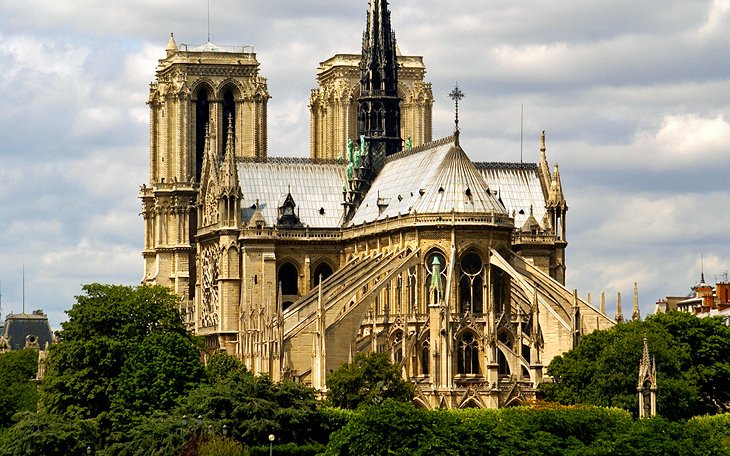
Cathédrale Notre-Dame de Paris
A triumph of Gothic architecture, the Notre-Dame stands in the heart of Paris on the Ile de la Cité near the attractions of the Latin Quarter. An island in the Seine River, the Ile de la Cité is the historical and geographical center of Paris. On this small plot of land, the Romans built the Gallo-Roman city of Lutetia, and from the 6th century to the 14th century, the Kings of France resided here.
The Notre-Dame Cathedral was founded in 1163 by King Louis IX (Saint Louis) and Bishop Maurice de Sully, and the construction took more than 150 years. The cathedral was first created in Early Gothic style, while later additions (the west front and the nave) show the transition to High Gothic style. Tourists are immediately struck by the ornamental design of the facade, with its profusion of sculptures and gargoyles, while elaborate flying buttresses provide structural integrity for the enormous building. Look out for the 21 figures above the doorway in the Gallery of Kings, who lost their heads during the Revolution. (The heads are now on display in the Musée de Cluny.)
After admiring the decorative doorway, enter the sanctuary to take in the grandeur of this immense vaulted space. The sanctuary seems almost endless and beckons visitors with the light of flickering candles. The interior is illuminated by magnificent stained-glass windows. The most noteworthy window is the rose window in the north transept. This stunning work of art features 80 Old Testament scenes centered around the Virgin.
Note: In April of 2019, a fire caused considerable damage to the cathedral. The interior is closed to the public. The structure will be undergoing repairs in the years ahead.
- 4. Avenue des Champs-Élysées
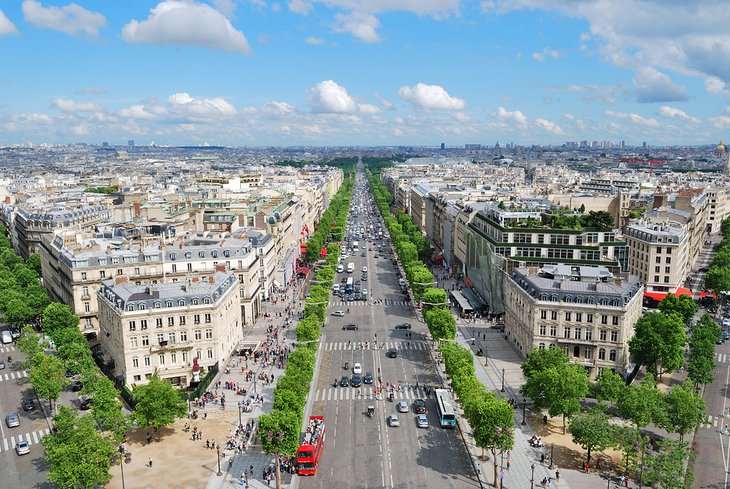
Avenue des Champs-Élysées
The most monumental boulevard in Paris used to be a desolate field of marshland until the 17th century, when it was landscaped by André Le Nôtre. A century later, the renowned Parisian city planner Baron Haussman designed the boulevard's elegant buildings. The Champs-Elysées is divided into two parts with the Rond-Point des Champs-Elysées as its intersection.
The lower part of the Champs-Elysées, bordering the Place du Concorde, includes a spacious park, the Jardin des Champs-Élysées, and the Petit Palais fine arts museum. The upper part, extending to the Arc de Triomphe, is lined by luxury shops, hotels, restaurants, cafés, cinemas, and theaters. This bustling area draws many tourists and is a gathering place for Parisians.
The Champs-Elysées is famous for its prestigious establishments, such as Maison Ladurée (75 Avenue des Champs-Elysées), a pâtisserie shop renowned for its 18th-century tea salon and delicious pastries (their specialty is "macarons"), and upscale designer boutiques like Tiffany & Co. (62 Avenue des Champs-Élysées), Louis-Vuitton (101 Avenue des Champs-Elysées), and Cartier (154 Avenue des Champs-Élysées).
For fine dining, the top choices are the legendary "brasserie du luxe" restaurant and hotel Le Fouquet's (99 Avenue des Champs-Élysées) and the swanky gastronomic restaurant L'Atelier Étoile de Joël Robuchon (82 Avenue Marceau, at the upper part of the Champs-Elysées near the Arc de Triomphe), which boasts a Michelin star.
Although the Champs-Elysées has an image of refinement, there are many affordable places that cater to tourists and students on a budget, such as the Disney toy store, H&M clothing shop, Starbucks, Quick, Burger King, and McDonald's.
5. Musée d'Orsay
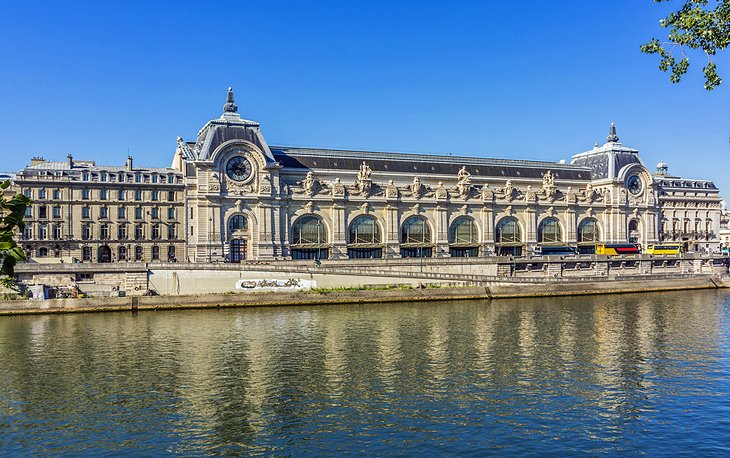
Musée d'Orsay
This splendid collection of Impressionist art is beautifully presented in an expansive space (formerly the Belle Epoque-era Gare d'Orsay railway station). The collection represents the work of all the masters of Impressionism. The artists range from classic Impressionist masters Edgar Degas, Edouard Manet, Claude Monet, and Pierre-August Renoir to Post-Impressionist artists such as Pierre Bonnard, Paul Cézanne, and Vincent van Gogh; the Pointillists (Georges Seurat, Paul Signac); and Bohemian artists like Toulouse Lautrec.
Some of the museum's most famous pieces include Claude Monet's The Magpie, Gare Saint-Lazare, Poppy Field, and Luncheon on the Grass; Vincent van Gogh's self-portrait and Starry Night; and Renoir's Dance at Moulin de la Galette, which depicts a festive party scene in Montmartre.
The Orsay Museum is among the best places to visit in Paris to get an overview of Impressionist art history—from the gentle brush strokes of Monet to the wild, colorful scenes of Gauguin. The museum also has two cafés and an upscale restaurant, which is worth the splurge. Formerly part of the Hôtel d'Orsay and listed as a Historic Monument, the museum's restaurant features gilded ceilings and sparkling chandeliers.
6. Palais Garnier, Opéra National de Paris
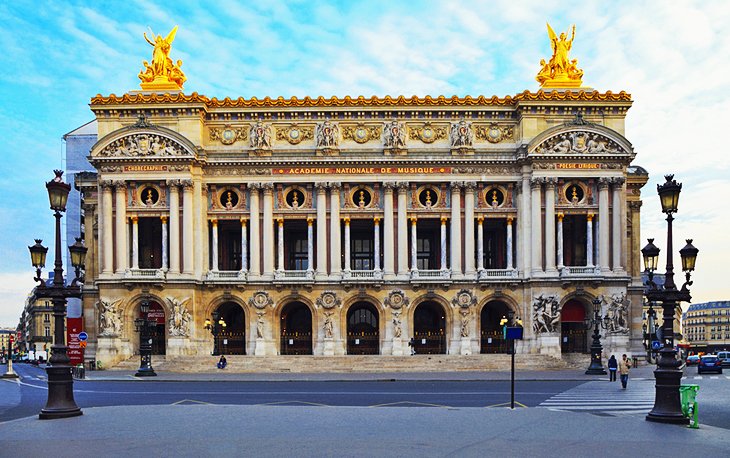
Palais Garnier, Opéra National de Paris
Commissioned by Napoleon III in 1860, the Palais Garnier Opera House was designed by Charles Garnier in an exuberant Baroque style. Garnier worked tirelessly on the project for over a decade, from 1862 to 1875. Today, the opulent monument is a symbol of Napoleon's Imperial regime.
The facade features classical columns and eight sculptures representing allegorical figures: Poetry, Music, Idyll, Recitation, Song, Drama, and Dance. The loggia depicts busts of composers, including Rossini, Beethoven, and Mozart, while the cupola is topped with a statue of Apollo with allegorical figures of Poetry and Music. Upon entering the building, visitors are dazzled by the lavish 11,000-square-meter interior. Most of the building's space is dedicated to the grand foyer with its fabulous Grand Escalier, marble entrance staircase, adorned by ornate gilded lamps.
The auditorium has an intimate feel, although it can accommodate 2,105 people in its plush red-velvet seats. Gilded balconies, an enormous crystal chandelier, and a Chagall ceiling painting add to the theater's marvelousness, creating the perfect dramatic backdrop for cultural performances.
For visitors looking for things to do at night in Paris, the Opéra Garnier hosts a prestigious calendar of events. Besides opera, there are ballet performances, classical music concerts, and gala events. Attending a performance is a wonderful way to see the building's interior and enjoy a glamorous evening. Another option is to visit during the daytime (entry ticket required).
For a deeper understanding of the Paris Opera House and its rich cultural heritage, tourists should visit the Bibliotèchque-Musée de l'Opera (Library-Museum of the Opera House) located inside the building. The library and museum contain three centuries of archives, as well as exhibits dedicated to the art of opera. The museum's permanent collection features drawings of costumes and scenery, scale models, and paintings of the building. The Opera House also has a boutique and a stylish contemporary restaurant, which serves Japanese-French fusion cuisine.
7. Place de la Concorde
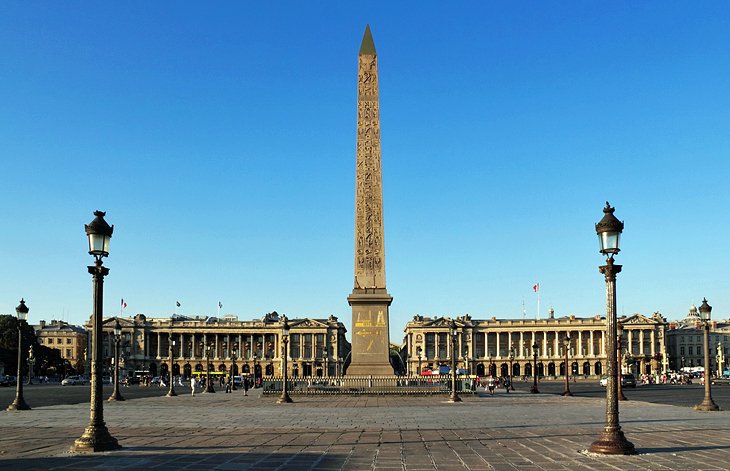
Place de la Concorde
Created between 1755 and 1775 by the architect of King Louis XV, this impressive octagonal square is at the heart of 18th-century Paris. With its majestic dimensions, the Place de la Concorde is one of the most attractive squares in the city. It was the scene of several key historical events, including the execution of King Louis XVI, and it was part of Napoleon's triumphal route.
The square offers sensational views of the triumphal route towards the Arc de Triomphe and the Défense, and towards the Louvre, as well as to the Madeleine and the Palais-Bourbon. At the center is an Egyptian obelisk, which was presented to Charles X by the Viceroy of Egypt. During summer, there is a Ferris wheel here.
The Place de la Concorde is a busy intersection with heavy traffic, circulating at high speeds. French drivers don't always pay attention to pedestrians, so tourists should make sure to get out of the way! To arrive at the Place de la Concorde, walk from the Louvre through the Jardin du Tuileries or the Rue du Rivoli, or follow the Quai along the Seine River. Alternatively take the Métro to Concorde station.
8. Arc de Triomphe
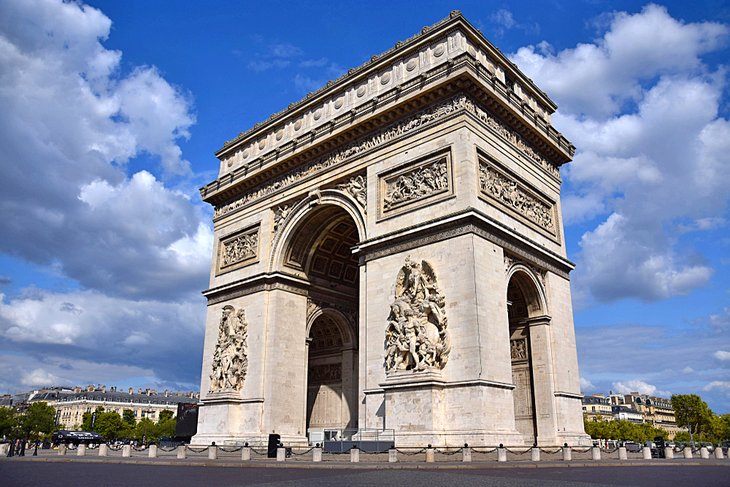
Arc de Triomphe
The Arc de Triomphe is dedicated to the soldiers who fought in the French armies of the Revolution and the First Empire (Napoleonic Wars). Napoleon commissioned the building of this mighty structure in 1806 but did not live to see its completion in 1836. Designed by JF Chalgrin, the massive 50-meter-high arch features bas-reliefs with larger-than-life-size figures, which depict the departure, victories, and glorious return of the French armies.
Particularly noteworthy is the bas-relief by François Rude on the Champs-Elysées-facing side: Departure of the Volunteers of 1792, also known as The Marseillaise, illustrating the troops led by the winged spirit of Liberty. On the inner surface of the arch are the names of more than 660 generals and more than a hundred battles.
From the top of the monument, a viewing platform affords panoramic views of the 12 avenues that radiate from the Place de l'Etoile, including the route from the Champs-Elysées to Place de la Concorde and the Louvre. It's possible to see all the way to La Défense, Montmartre, and the Eiffel Tower.
At the foot of the Arc de Triomphe is the Tomb of the Unknown Soldier, dedicated in 1921 as a memorial to an anonymous soldier (symbol of the many other unknown soldiers who valiantly died for their country during World War One without ever receiving recognition). The Flame of Remembrance was ignited on November 11th, 1923 and since that date has not ever been extinguished. Every evening at 6:30pm, a ritual takes place to rekindle the memorial flame at the tomb.
Today, events to honor national holidays are held at the Arc de Triomphe, including the November 11th (anniversary of the Armistice of 1918) ceremony commemorating those who perished in the war; the May 8th Fête de la Victoire (Victory Day) celebrating the end of WWII, and the liberation from Nazi occupation; as well as festivities for July 14th (Bastille Day).
Guided tours of the Arc de Triomphe are available in English, French, and Spanish. Another option is to take a Skip-the-Line Tour, which allows quick access to the monument, avoiding the long queues.
9. Seine River Cruises
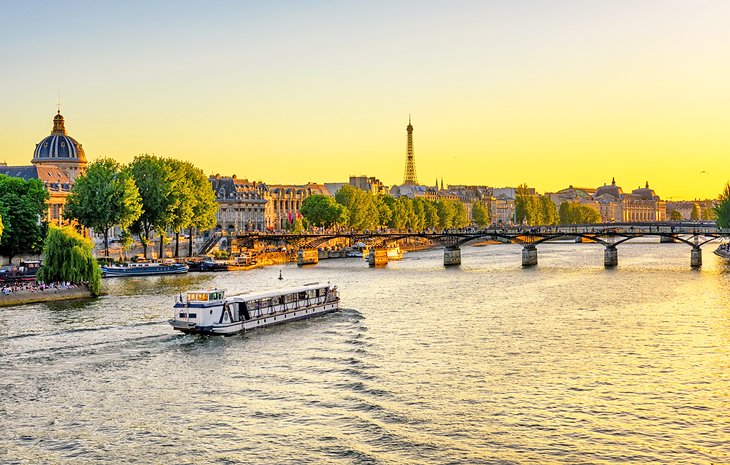
Seine river cruise at sunset
To truly soak up the alluring ambience of Paris, tourists should try taking a boat cruise along the Seine River. Besides being one of the most enjoyable things to do while visiting the city, Seine River Cruises allow tourists to see the sights from a different perspective. The Seine River bridges, Eiffel Tower, Notre-Dame Cathedral, and the Louvre Museum look stunning from the viewpoint of a riverboat.
While a daytime cruise allows tourists to appreciate the glory of the monuments brightened by sunshine, the most romantic experience is an evening cruise. After sunset, the city's landmarks are illuminated, which creates a special effect, and somehow the city seems more magical. For a cruise that includes dinner, try the Bateaux Parisiens Seine River Cruise. This four-hour sightseeing journey departs near the Eiffel Tour, and guests are treated to a gourmet three-course meal.
10. Musical Concerts at Sainte-Chapelle
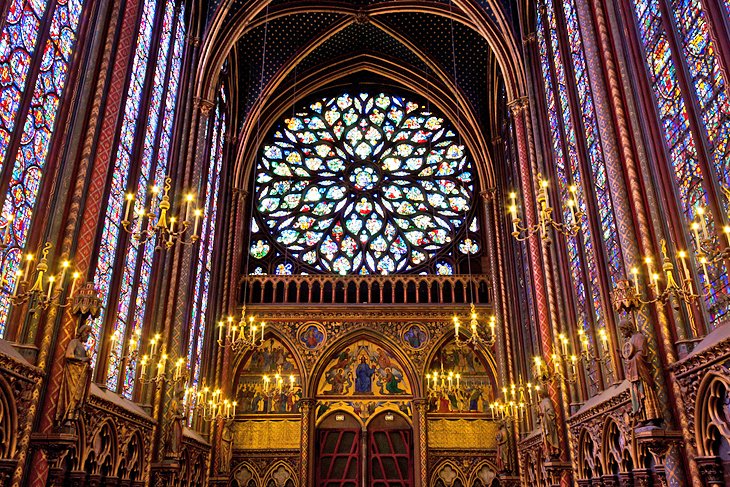
Sainte-Chapelle
Sainte-Chapelle is rarely used for mass but often serves as a venue for music concerts. Listening to a choir or classical music performance in this space is an inspiring spiritual experience. Sainte-Chapelle is considered a rare jewel among medieval houses of worship and is certainly one of the most exquisite churches in Paris.
This masterpiece of Rayonnant Gothic architecture was built from 1242 to 1248 for King Louis IX (Saint Louis) to house the precious relics he had acquired from the Byzantine Emperor. The altar displays a relic of the Crown of Thorns.
The chapel is renowned for its breathtaking stained-glass windows, which give the sanctuary an iridescent glow and serene aura. (It's recommended to visit in the morning and especially on sunny days to appreciate the windows at their most brilliant.) The chapel has 15 stained-glass windows (covering 600 square meters) depicting over 1,000 scenes from the bible, both Old Testament and New Testament stories. The colors and light symbolize divinity and the Heavenly Jerusalem.
Sainte-Chapelle is located in the Palais de la Cité. To find the chapel, enter the iron gate of the Palais de Justice and walk through the inner courtyard. Guided tours are available every day between 11am and 3pm.
Another attraction nearby is La Conciergerie (tourists may purchase combined entry tickets).
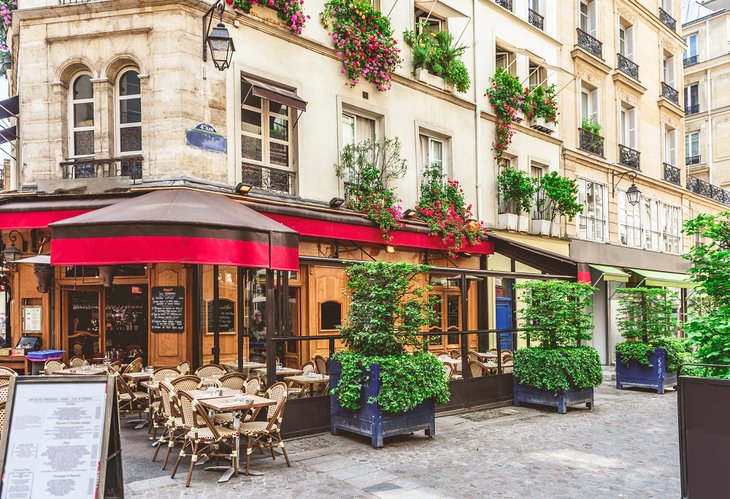
Famous Paris Cafe | Roger Salz / photo modified
To discover the legendary Paris cafés, the best place to start is the Boulevard Saint-Germain in the 6th arrondissement. This broad tree-lined boulevard is lined with designer fashion boutiques, prestigious cafés, and classic brasseries. The most celebrated cafés are the Café de Flore (172 Boulevard Saint-Germain), which was the meeting place of Jean Paul Sartre and Simone de Beauvoir, and the Café des Deux Magots (6 Place Saint-Germain-des-Prés), the haunt of James Joyce, Picasso, Hemingway, and other creative types. At both cafés, tourists are treated to a classic Parisian café experience, complete with waiters wearing bow ties (although the waiters have a reputation for their brusque service).
The brasseries of Boulevard Montparnasse were also frequented by famous artists and writers. Le Dôme in Montparnasse is a Paris institution (108 Boulevard du Montparnasse). In its glittering Art Deco dining room, the restaurant serves gourmet cuisine focused on seafood.
La Coupole (102 Boulevard Montparnasse) is another classic French brasserie with a mythical past; since the 1920s it was visited by famous artists such as André Derain, Fernand Léger, Man Ray, Pablo Picasso, and Marc Chagall. La Coupole also boasts having served Albert Camus and Jean-Paul Sartre. Le Rotonde (105 Boulevard Montparnasse) was a gathering place for painters and Surrealistic artists in the 1920s and still attracts cinematographers and artists today.
12. Luxembourg Gardens
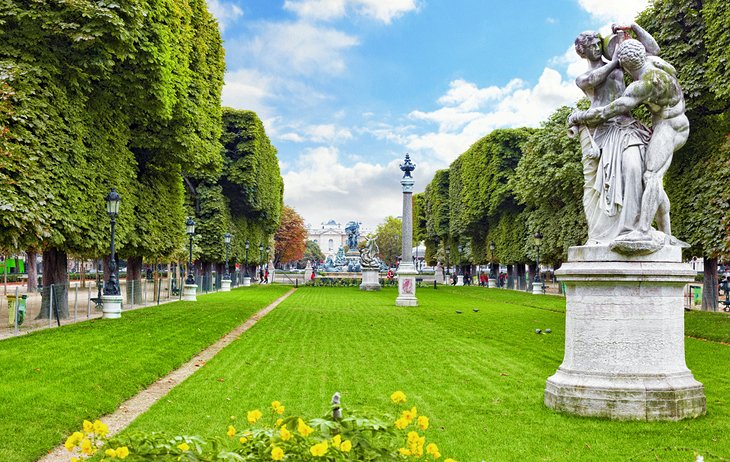
Luxembourg Gardens
The Luxembourg Gardens are the best known park in Paris after the Tuileries. The gardens were laid out in the 17th century when the Palais du Luxembourg was built, but they were given their present form in the 19th century by the architect J.F. Chalgrin. The central feature of the park is the large octagonal fountain-adorned pool, which is flanked by two terraces lined with statues, orderly geometric rows of flowerbeds, and manicured shrubbery. This part of the park exemplifies French classical style, with many chairs spread about for visitors to use.
Another key feature is the picturesque 17th-century Fontaine de Médicis, a fountain basin hidden under trees opposite the east front of the Palais du Luxembourg, the palace that King Henri IV created for his wife Marie de Medici. Nearby is the Pavillon de la Fontaine, a little café with pleasant outdoor seating in a shady forest setting.
The park is a locals' favorite spot for relaxing and picnicking. Students of the Latin Quarter can be seen here enjoying baguette sandwiches for lunch or just lounging on a sunny day. Recreational opportunities include basketball, tennis, and chess. Children enjoy the playground with a swing and pony rides. The most popular activity for the youngest visitors is steering miniature sailboats around in the octagonal pool (the boats can be hired at a kiosk by the pond).
For French-speaking children, the traditional marionette shows at the Théâtre des Marionnettes are a popular pastime. The Théâtre du Luxembourg, in the southwest of the park near the tennis courts, presents adorable puppet shows in French.
13. Sacré-Coeur and Quartier Montmartre
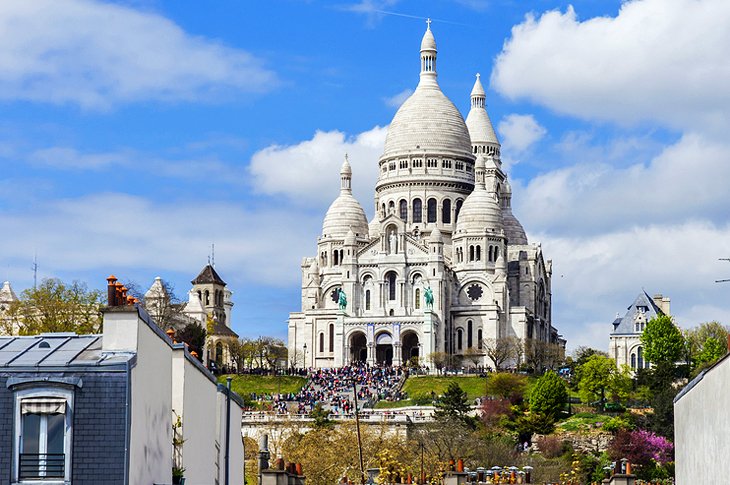
Sacré-Coeur and Quartier Montmartre
Sitting at the highest point in Paris like an ornamental decoration, the Basilique Sacré-Coeur has a special aura. Its alabaster facade blends Romanesque and Byzantine styles, and from far away, it looks like a wedding cake (which is its nickname).
Inside the Basilica, the striking mosaic of Christ with a flaming heart gives the sanctuary an emotional and spiritual intensity, fitting for a church that was created as a symbol of hope after the Franco-Prussian War. The sanctuary is illuminated with many candles, which provide a contrast to the dark, somber space.
Visitors can spend time on the terrace admiring the views of Paris or climb the tower for an even higher perspective. The Esplanade that leads up (by a staircase of over 200 steps) to the Sacré-Coeur church is a popular area for people to hang out and is often animated by street musicians.
While visiting the Sacré-Coeur, it's worth spending time exploring Montmartre. Once a little medieval village in the country, Montmartre blends old-fashioned charm with an avant-garde edge. Winding cobblestone streets and pedestrian staircases lead to quaint boutiques, hidden art galleries, and quiet squares filled with outdoor cafés.
During the Belle Epoque, the village of Montmartre began to attract artists such as Toulouse Lautrec and Edgar Degas. The Bohemian creative spirit of Montmartre is still found here, especially around the Place du Tertre and the Carré Roland Dorgelès. There are also many excellent art museums, including the Musée du Montmartre (12 Rue Cortot) and the Dali Museum (11 Rue Poulbot).
14. Panthéon
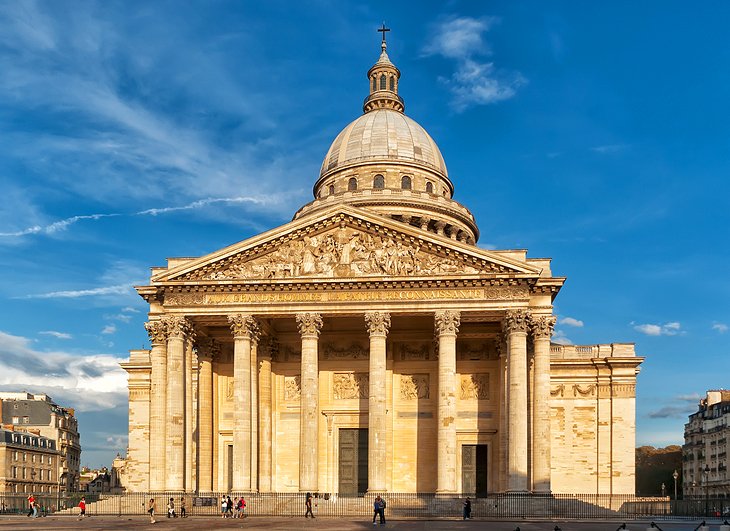
Panthéon
Built as a church to rival Saint Peter's Basilica in Rome and Saint Paul's Cathedral in London, the Panthéon is the national mausoleum of France's greatest citizens. In 1756, King Louis XV commissioned the architect Jacques-Germain Soufflot (1713-80) to build a new church on the site of the ruined abbey of Sainte-Geneviève, and the church was completed in 1790.
The architecture of the Panthéon marks a clear break from the playful Rococo of the Louis XV style and instead presents a simpler and more somber Neo-Classical style. The inscription on the Panthéon's facade reads "Aux grands hommes la patrie reconnaisante" indicating that the monument was originally dedicated exclusively "to the great men who are recognized by their country").
Many famous men (72 in total) are buried here, including philosophers Voltaire and Jean-Jacques Rousseau and the writers Victor Hugo, Alexandre Dumas, Emile Zola, and André Malraux. More recently (since 1995), several of France's most esteemed female citizens have been buried in the Panthéon including the physicist Marie Curie, a two-time winner of the Nobel Prize. Four other women are buried at the Panthéon.
From April until October, visitors may ascend to the Panthéon's dome, where a colonnaded balcony provides a sensational viewpoint of the city's landmarks. Panoramas extend from the Notre-Dame Cathedral and the Louvre in the foreground to the Eiffel Tower in the distance.
15. Place de Vosges
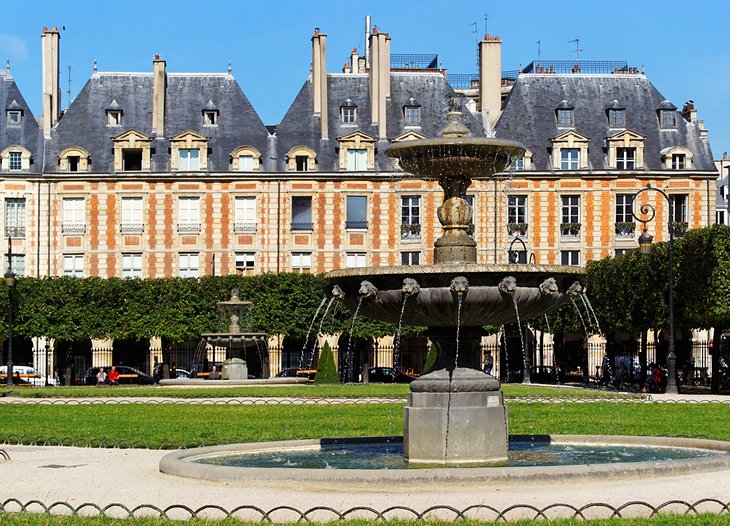
Place de Vosges
In the charming Marais district, the Place des Vosges is Paris' oldest public square, spaciously laid out in harmoniously uniform style. This elegant square provided a model for other squares such as Place Vendôme and Place de la Concorde. The Place de Vosges was constructed between 1605 and 1612 and was originally called Place Royale because it was filled with aristocratic residences. Typical of Renaissance architecture, the square has a pleasing symmetrical form with uniform houses of red brick, stone detailing, and pitched slate roofs.
The Place de Vosges offered a splendid setting for festive occasions in the 17th century, such as tournaments, state receptions, and court weddings. It was also a favorite spot for duels, in spite of Cardinal Richelieu's ban on dueling. The celebrated courtesan of Louis XIII's reign lived at number 11, and the future Madame de Sévigné was born in 1626 at number 1 on the square.
The Place de Vosges is at the heart of the Marais Quarter, a historic area with medieval and Renaissance palaces. In one of the neighborhood's stately mansions, the Hôtel Salé, the Musée National Picasso (5 Rue de Thorigny) wows modern art lovers with its incredibly extensive collection (thousands of pieces) of Picasso's artwork, including some of his most iconic masterpieces.
The Marais has become a trendy quarter and has a significant Jewish community. To learn more about Jewish culture in Europe, tourists can visit the Musée d'Art et d'Histoire du Judaïsme (71 Rue du Temple), which presents a history of various Jewish communities in Europe along with artwork by Jewish artists such as Chagall and Modigliani.
Nearby, the Jardin Anne Frank is a tranquil secluded garden with an orchard. For those in search of a refined Parisian experience, the Mariage Frères (30 Rue du Bourg Tibourg) is the place to go. This tea salon serves its aromatic tea with savory and sweet delicacies; its adjoining shop sells a wide selection of the finest teas in Paris. Many tourists wait in line to try the authentic falafel at L'As du Fallafel (32-34 Rue des Rosiers). Also worth noting: The Marais is one of the areas of Paris where the shops and boutiques are open on Sundays.
16. Place Vendôme
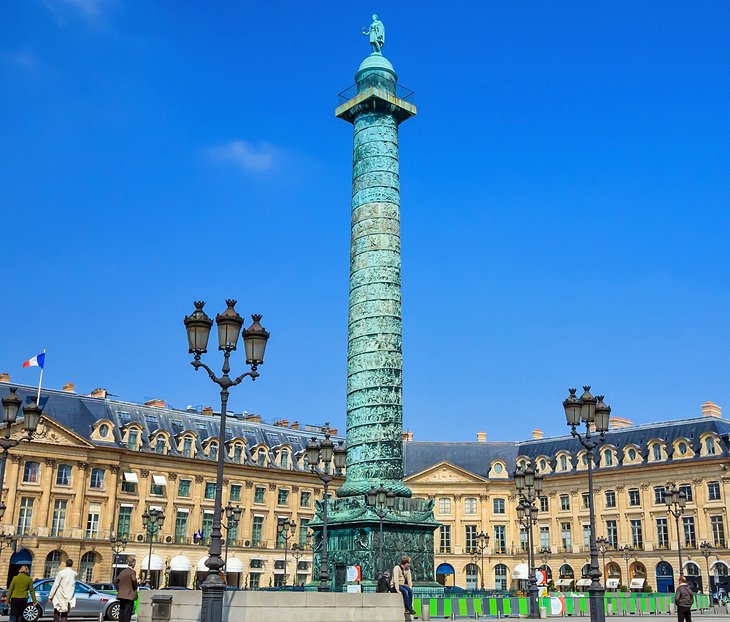
Place Vendôme
This graceful square was laid out by Jules Hardouin-Mansart, one of the leading architects of the "Grand Siècle" under King Louis XIV. Originally, the square was called Place Louis le Grand. The facades of the houses were built between 1686 and 1701. The original intention was that the royal academies, the Mint, the Royal Library, and a hotel for foreign envoys would be installed in the square, but due to financial difficulties, the King was forced to sell the buildings to nobles and wealthy citizens. The new owners built gorgeous mansions with courtyards and gardens.
The charm of the Place Vendôme is that it has retained the consistency of the overall design, which combines regal ostentation with civic simplicity. Following careful restoration in the early '90s, it has been restored in all its splendor.
The square is known for its upscale jewelry boutiques including Boucheron, Chanel, Van Cleef & Arpels, and Cartier. Another luxury establishment here is the Ritz Hotel, which was frequented by Ernest Hemingway, Scott Fitzgerald, and Gertrude Stein. Coco Chanel made the Ritz Hotel her home for 34 years; she decorated her suite in her signature chic style, with velvet-upholstered sofas, lacquered furniture, and gilded mirrors.
At the center of the Place Vendôme stands a landmark of historic importance, the Colonne de la Grande Armée. Built between 1806 and 1810, the 42-meter-high column is dedicated to Napoleon and his Grande Armée (army) who fought heroically and victoriously in the Battle of Austerlitz (in December 1805). The column's facade is crafted from bronze plaques embossed with 108 spiraling bas-relief friezes (similar to the Trajan's Column in Rome), which tell the story of the glorious events that took place during Napoleon's campaign of 1805.
17. Centre Pompidou
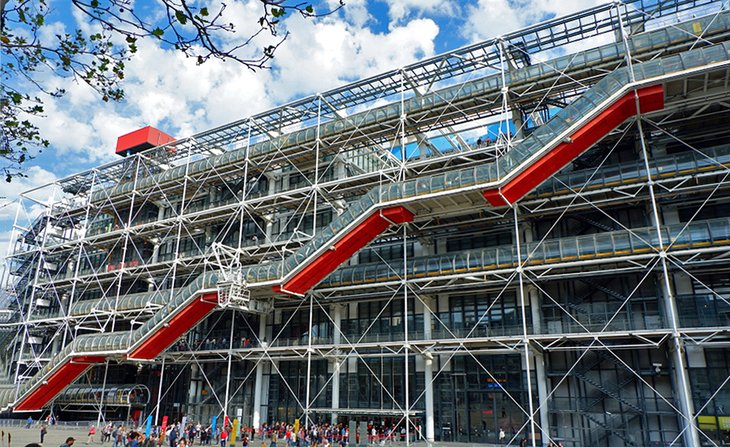
Centre Pompidou
Between the Halles district and the Marais in Paris is the Centre Pompidou, an art and cultural center. In contrast to the historic buildings of the quarter, the Centre Pompidou features shocking modern architecture, sometimes described as an "inside out" design because the architectural details of staircases and elevators appear on the exterior.
The main attraction of the Centre Pompidou is the National Museum of Modern Art, which displays an extensive collection (over 100,000 pieces) of contemporary art (created from 1905 to the present), beginning with the Post-Impressionist "Fauves" and "Les Nabis" movements (André Derain, Raoul Dufy, Henri Matisse, and Pierre Bonnard), continuing with Cubism (Pablo Picasso, Georges Braque, and Fernand Léger), then Expressionism, Constructivism (Paul Klee and Piet Mondrian), Dadaism and Surrealism (Salvador Dalí, Max Ernst, René Magritte, and André Masson), Abstract Expressionism (Mark Rothko, Nicolas de Staël, Hans Hartung, and Serge Poliakoff), Informal Art (Jean Dubuffet), New Realism, and Pop Art (Andy Warhol, Claes Oldenburg). The center has a bookshop and souvenir store as well as a casual café and a sleek contemporary-style restaurant.
18. Les Invalides
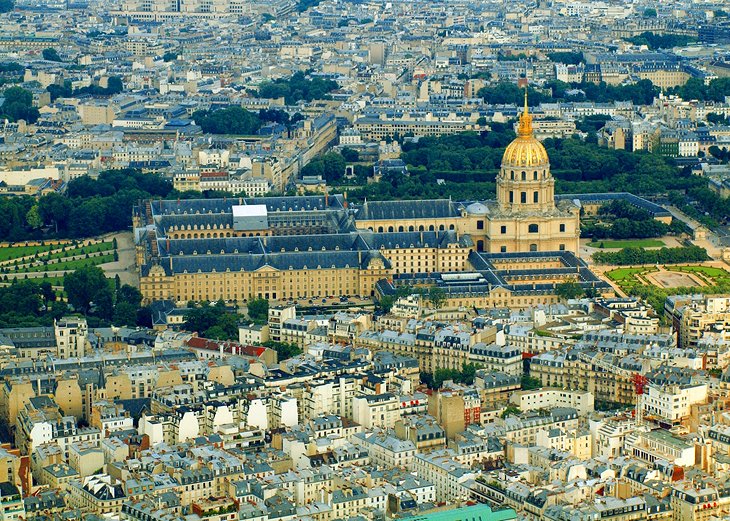
Les Invalides
The Hôtel des Invalides was founded as a home for disabled soldiers. Before the time of Louis XIV, disabled soldiers received medical care, if at all, in hospitals or monasteries, but were usually reduced to begging. With the Hôtel des Invalides the "Sun King" founded the first home for men that became disabled while serving in his armies.
The building was created from 1671 to 1676 under the direction of the architect Libéral Bruant and centered on the Eglise Saint-Louis-des-Invalides, which was later redesigned by the architect Jules Hardouin-Mansart in 1706. The church became known as the Eglise du Dôme des Invalides and is an outstanding ecclesiastical building of the French classical period. The Eglise du Dôme des Invalides is most famous for being the site of Napoleon's Tomb, installed here in 1840.
Les Invalides has an Army Museum, founded in 1794 as the Artillery Museum, which occupies the wings around the courtyard. The museum displays a large collection of military equipment and uniforms, weapons, prints, and curiosities from many countries. There are also mementos and relics of Napoleon and well-known generals, as well as plans of the French campaigns.
19. Palais-Royal
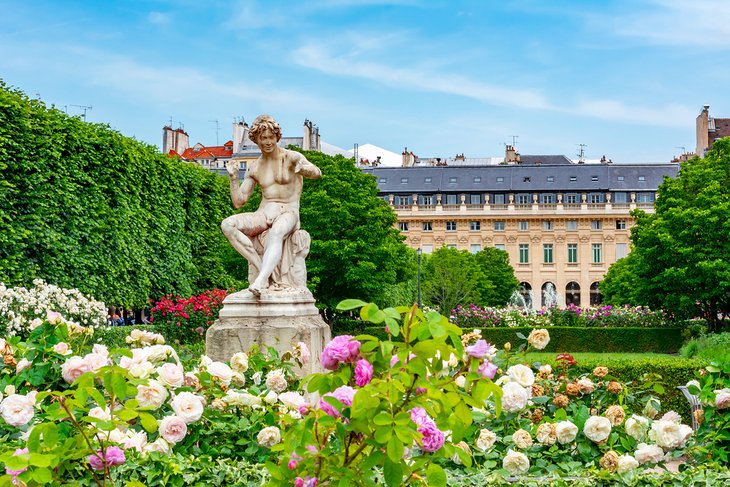
Palais-Royal | crossine0 / photo modified
Opposite the Louvre Museum is another example of royal architecture. The Palais-Royal was created as a palace for Cardinal Richelieu during the reign of King Louis XIII and later became a royal place; it was a seat of power for four centuries. Exemplifying classical French architecture, the Palais Royal is made up of 60 pavilions surrounding a lovely garden, the Jardin du Palais-Royal. This quiet enclosed space has the feeling of being its own little village within the city.
The buildings are connected by a colonnaded pathway and arcaded galleries (verandas) filled with high-end boutiques. There are also a couple of cute cafés and two fine dining restaurants: the haute-cuisine Restaurant du Palais Royal (one Michelin star) and Le Grand Véfour (two Michelin stars) in an ornate "art décoratif" dining room.
The Palais-Royal "village" also includes the Palais-Royal theater and Comédie-Française theater, as well as a modern sculpture installation in the main courtyard. A favorite place for locals to take a leisurely stroll, the Palais-Royal is open to the public every day, free of charge. Guided tours are available in English, French and Spanish.
20. Place de Bastille
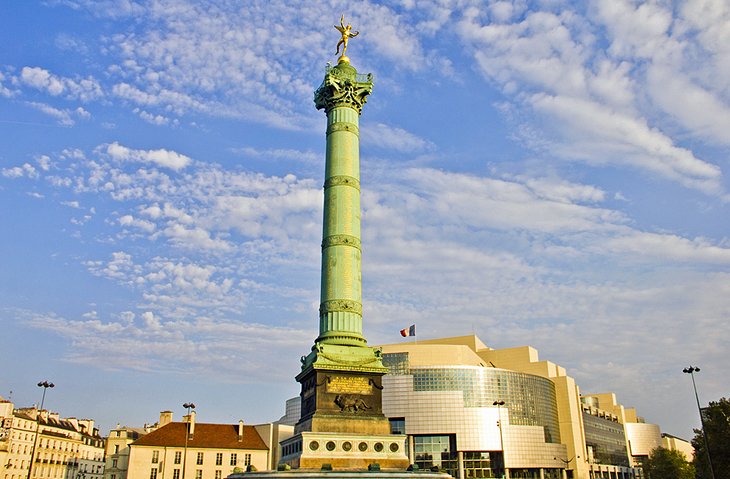
Colonne de Juillet, Place de la Bastille
Now, only the name of this square is a reminder that the notorious state prison known as the Bastille, the much-hated symbol of absolutist power, once stood here. After the storming of the Bastille on July 14, 1789, the prison was completely demolished.
In the center of Place de la Bastille is the 51-meter-high Colonne de Juillet, topped by a graceful gilded figure of Liberty. The monument commemorates the July Revolution of 1830, which overthrew King Charles X and brought Louis-Philippe to power. Four Gallic cocks and a lion relief on the base of the column symbolize the free people of France. A spiral staircase of 283 steps inside the column leads to a viewing platform.
On the site of the Bastille prison is the new Opera House, the Opéra-Bastille, that was inaugurated by President Mitterrand on July 13, 1989. This immense modern theater has seating for 2,745 people. Both the view of the stage from the auditorium and the acoustics are superb. The Opéra-Bastille has a year-round calendar of events with performances by the Paris Opera Orchestra, the Paris Opera Chorus, and the Paris Opera Ballet companies. Tourists may enjoy attending one of the performances and then exploring the Bastille area. This trendy neighborhood is brimming with quirky boutiques, hip clothing shops, stylish restaurants, and happening cafés.
21. Châtelet and Tour Saint-Jacques
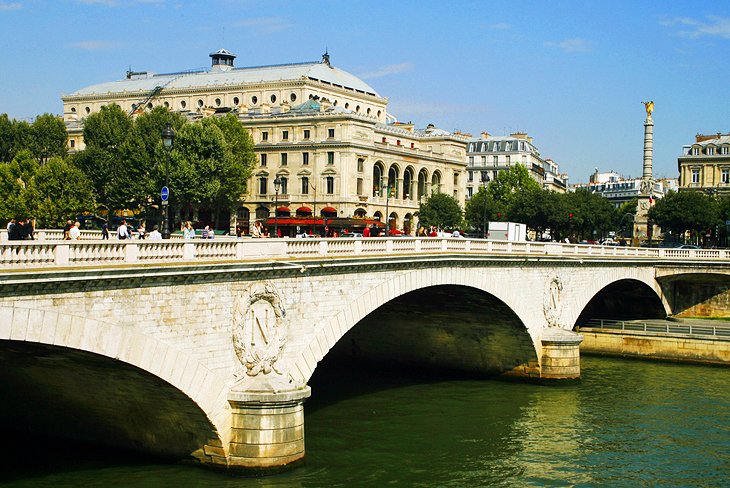
Place du Châtelet & Tour Saint-Jacques
The Place du Châtelet stands at the very center of Paris in the 1st arrondissement, overlooking the Seine River. Gracing this expansive square are two celebrated Parisian theaters: The 19th-century Théâtre du Châtelet presents a wide variety of performances. The Théâtre de la Ville is a listed historic monument, which was once named after Sarah Bernhardt who directed shows here; this theater stages a diverse program of dance and theater performances, as well as classical and international music concerts.
The area around Place du Châtelet is also worth exploring. Continue towards the Rue de Rivoli, past the Boulevard de Sébastopol, and wander through the small park to find the Tour Saint-Jacques. Built between 1508 and 1522 in the Late Gothic style, this tower is all that remains of the Eglise Saint-Jacques-de-la-Boucherie (the patron saint of butchers), the town's old parish church. During the Middle Ages, this church was the meeting point for pilgrims embarking on the "Way of Saint James" pilgrimage trail to Santiago de Compostela, one of the three epic pilgrimage destinations of medieval Christendom (the others being Jerusalem and Rome).
The Saint-Jacques Tower is also famous as the place where Blaise Pascal conducted one of his barometric experiments, which showed the effect of altitude on the height of a column of mercury.
22. La Conciergerie

La Conciergerie
Never mind the inviting name, this imposing medieval fortress is the infamous prison of the French Revolution. Here, prisoners including Marie-Antoinette and Robespierre were kept in dank cells while awaiting their fate. The Salle des Girondins displays relics of the bloody days of the Terror, including a guillotine blade, prison regulations, and a copy of Marie-Antoinette's last letter.
The Salle des Gens d'Armes is a vaulted Gothic hall of awesome proportions. In this forbidding room, the condemned prisoners were handed over to the executioner. For an exceptional view of the building's Neo-Gothic facade, stand on the opposite side of the Seine River on the Quai de la Mégisserie. From this distance, with its three round towers and the Tour de l'Horloge (Clock Tower), the fortress resembles a fairy-tale castle rather than a penitentiary. The Conciergerie is now open to the public as a museum. It's possible to purchase a combined entry ticket for the Conciergerie and Sainte-Chapelle.
23. Fondation Louis Vuitton
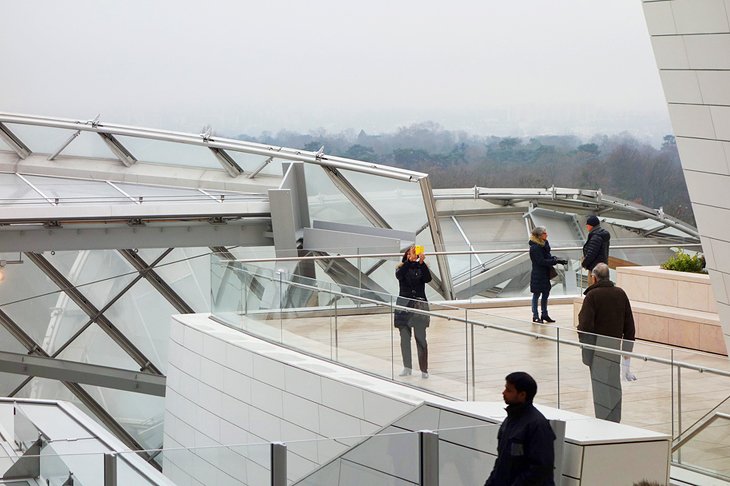
Fondation Louis Vuitton
The former hunting grounds of France's kings, the Bois de Bologne park is now home to a surprising new landmark. Opened in 2014, the Fondation Louis Vuitton was commissioned by Bernard Arnault, chairman of the Louis Vuitton Moët Hennessy corporation. The private museum will eventually become the property of the French state.
Designed by Frank Gehry, an acclaimed American architect based in Los Angeles, the striking building is a masterpiece of ultra-modern architecture. The sleek exterior resembles an iceberg or an enormous ship with flowing sails made out of glass (3,600 glass panels in total create the dramatic effect). To create the structure, engineers remarkably used more steel than the amount in the Eiffel Tower.
Within the museum's 3,500 square meters of exhibition space are 11 different galleries. Illuminated by natural light, the exhibition space is airy and bright, ideal for showing off the contemporary art collections. In keeping with the museum's modern theme, the permanent collection focuses entirely on 20th-century and 21st-century art organized in four different categories: Expressionism, Contemplative Art, Pop Art, and Music & Sound.
The Fondation Louis Vuitton offers a year-round calendar of events and temporary exhibits. Cultural events and music performances are presented in a 1,000-seat auditorium. Tourists may also enjoy a snack or meal at the museum's café-restaurant, which offers a menu created by a Michelin-starred chef.
Not to be missed are the three outdoor terraces on the roof, which afford sweeping views of the Bois de Bologne, the La Defense quarter, and the Eiffel Tower in the distance. After admiring panoramas of the scenery, tourists can explore the walking paths and botanical garden at the Bois de Bologne.
24. Parc de la Villette
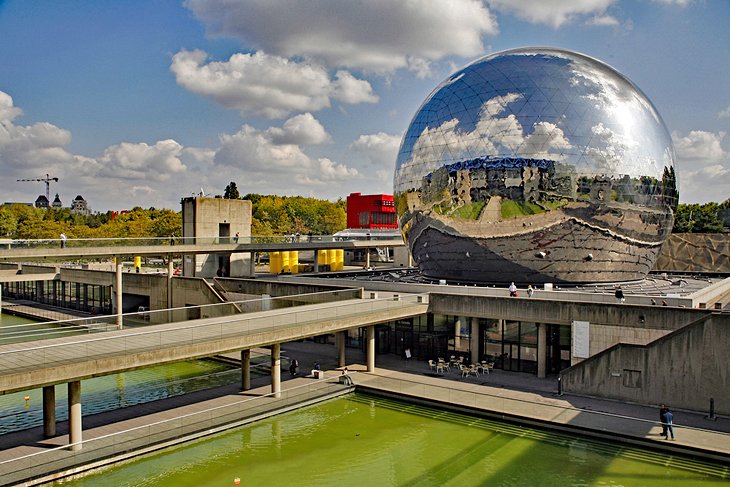
La Géode IMAX theater
Covering 55 hectares, the Parc de la Villette is the largest landscaped green space in Paris. The park is brimming with attractions, including children's playgrounds and the Cité des Sciences et de l'Industrie (Museum of Science and Technology). The park is also home to the Géode IMAX theater, the Zénith de Paris performance venue, and the Philharmonie de Paris concert halls. An outdoor film festival takes place in the park from mid-July to mid-August.
Garden lovers will appreciate the park's variety of themed gardens, featuring paths and footbridges. The area around the Canal de l'Ourcq is embellished with ponds and fountains.
25. Paris Plages
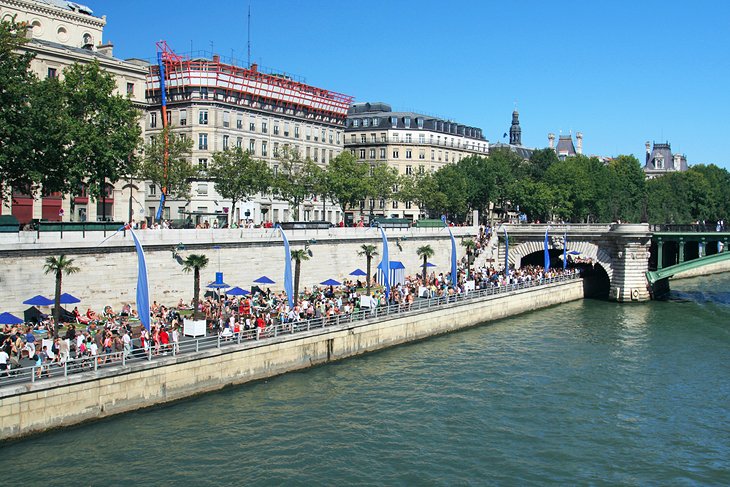
Seine River bank
On warm, sunny days during the summer months (July 7th to September 2nd), Parisians flock to the banks along the Seine River for a mini holiday experience. The city of Paris brings public amenities to several areas, which are designed especially for relaxation and recreation.
Within the Parc Rives de Seine, the "vacation spots" are found from the Pont Alexandre III to the Pont de Solferino on the Left Bank and from the Pont Neuf to the Pont de Sully on the Right Bank. Within these areas, the lawns of the quays are transformed into little resorts, complete with lounge chairs, sun umbrellas, and palm trees. Beach towels and children's toys are also available. Recreational opportunities include table football and mini golf games for kids, and ballroom dancing, exercise routines, and tai chi classes for adults.
Another "beach" resort along the Seine is found at the Bassin de la Villette canal (on the Quai de Loire and the Quai de Seine). There are three swimming pools with lifeguards at Quai de Loire (open July 20th to September 9th). Sports activities at the canal include canoeing, pétanque, chess, board games, and ziplining. The Bassin de la Villette also has quayside "beach" huts, showers, toilets, snack bars, and ice-cream stands.
26. Cimetière du Père Lachaise
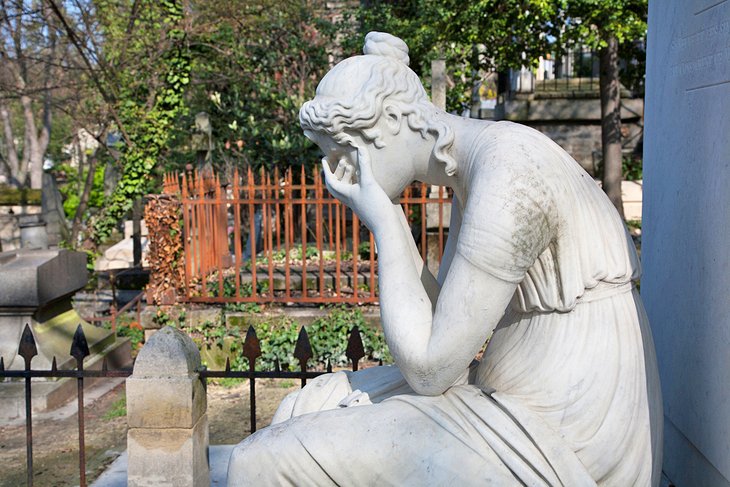
Père Lachaise Cemetery
Away from the more touristy areas of central Paris in the 20th arrondissement, the Père Lachaise Cemetery is the city's most famous and most visited cemetery. This 44-hectare space is the final resting place of many famous men and women, including Honoré de Balzac, Frédéric Chopin, Edith Piaf, Oscar Wilde, and Jim Morrison. Some of the tombs and graves of the most admired personalities attract a cult following, with flowers and tributes left by visitors on a daily basis.
27. Parc des Buttes-Chaumont
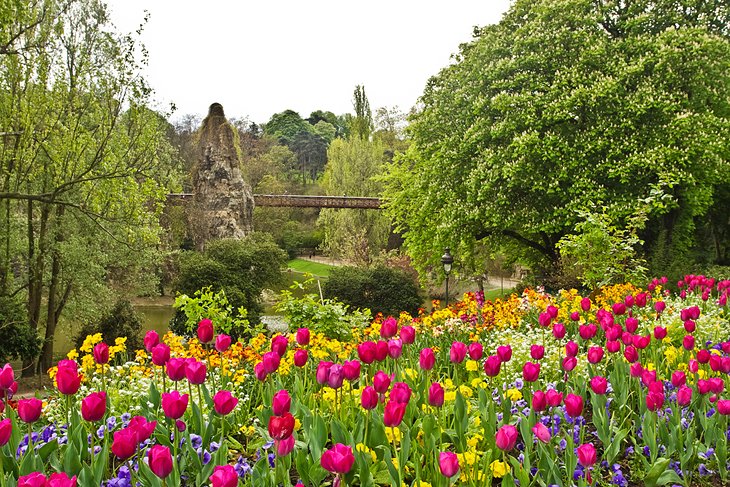
Parc des Buttes-Chaumont
A peaceful little oasis of nature that is treasured by locals, the Parc des Buttes-Chaumont is completely unlike the restrained formal gardens of Paris. Instead of orderly rows of flowerbeds, geometric hedges, and perfectly manicured trees, the Buttes-Chaumont Park has the feeling of an untamed pastoral landscape. Caves, waterfalls, and an artificial lake add to the Romantic aesthetic. Large shady trees and spacious grassy areas invite visitors to pull out a blanket and relax.
Among Parisians, this park is a favorite place to go for picnics on warm days. Other choices for snacks at the park include a convivial Bohemian-style snack bar with musical entertainment and an outdoor patio and Le Pavillon du Lac, a cozy gourmet restaurant with a terrace overlooking the lake.
28. Grand Arche of La Défense
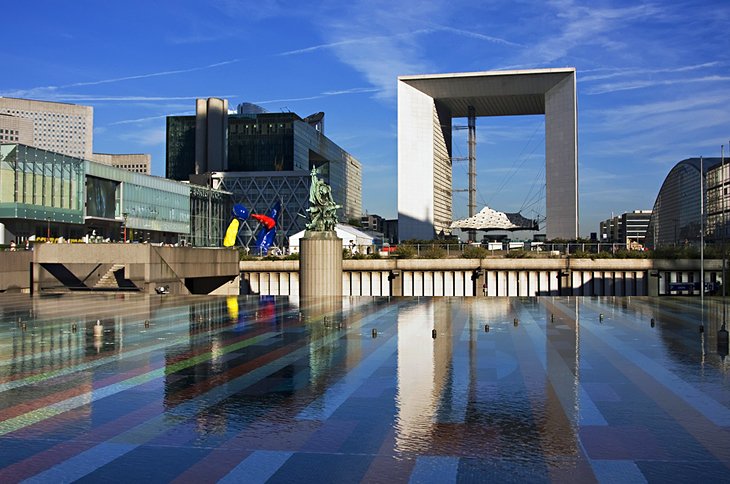
Grand Arche of La Défense
In the west of Paris at the end of Avenue Charles-de-Gaulle is a complex of high-rise buildings developed since the mid 1960s. The quarter is named La Défense, which recalls the bitter resistance by French forces in this area during the Franco-Prussian War of 1870-1871.
Nowadays, this neighborhood is seen as heralding Paris' entry into the 21st century. Designed by Johan Otto von Spreckelsen, the Grande Arche makes a striking impression. This huge 110-meter-high rectangular triumphal arch is faced with white Carrara marble. The monument was inaugurated in 1989 on the bicentenary of the French Revolution, and the contemporary structure symbolizes France's national value of fraternity.
(thanks to: www.planetware.com)
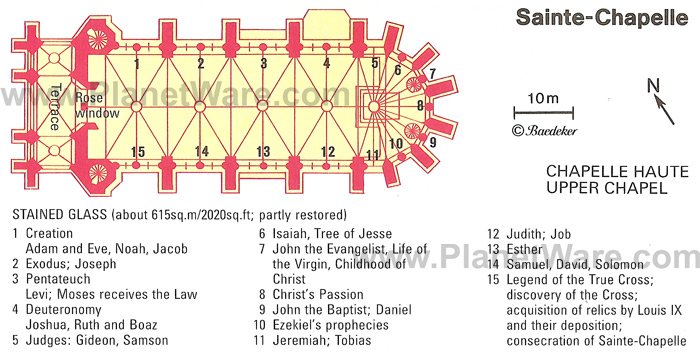
Comments
Post a Comment